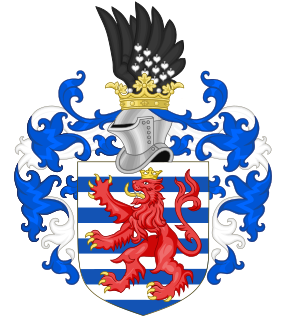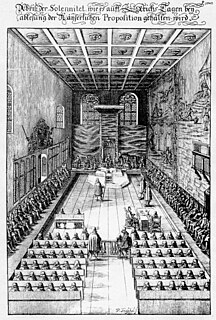| Ruler | Born | Reign | Death | Ruling part | Consort | Notes |
|---|
| Conrad I | | ? | 1099-1122 | 1122 | County of Württemberg | Unknown | Considered to be founder of the Württemberg dynasty. |
| Conrad II | | ? | 1122-1143 | 1143 | County of Württemberg | Unknown | His mother, Luitgard of Beutelsbach, was a sister of Conrad I. He served as marshal of Swabia [1] and advocate of the town of Ulm, and had large possessions in the valleys of the Neckar and the Rems. Based on the similarity between their coats of arms, it is believed that Conrad II belonged to the family of the Counts of Veringen (Veringenstadt). |
| Louis I | | c.1098 | 1143-1158 | 1158 | County of Württemberg | Unknown
at least one child | He presumably was Vogt of the Denkendorf monastery. |
| Louis II | | c.1137 | 1158-1181 | 1181 | County of Württemberg | Willibirg of Kirchberg
(1142-1179)
two children | |
| Hartmann | | c.1160 | 1181-1240 | 1240 | County of Württemberg | ? of Veringen
no children | Sons of Louis II, ruled jointly since 1194. Hartmann inherited Veringen estates through his marriage. Hartmann's children founded a branch of counts of Grüningen-Landau. |
| Louis III | | 1166 | 1194-1241 | 1241 | County of Württemberg | ? of Dillenburg/Kyburg
four children |
| Ulrich I the Founder |  | 1226 | 1241-1265 | 25 February 1265 | County of Württemberg | Matilda of Baden
three children
Agnes of Legnica
(d.13 March 1265)
one child | Grandson of Hartmann I, through his son Hermann. |
| Ulrich II | | 1254 | 1265-1279 | 18 September 1279 | County of Württemberg | Unknown | |
| Eberhard I the Illustrious |  | 13 March 1265 | 1279-1325 | 5 June 1325 | County of Württemberg | Unknown
two children
Margaret of Lorraine
one child
Irmengard of Baden
three children | |
| Ulrich III | 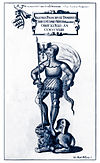 | c.1290 | 1325-1344 | 11 July 1344 | County of Württemberg | Sophia of Pfirt
1312
two children | |
| Eberhard II the Jarrer |  | c.1315 | 1344-1392 | 15 March 1392 | County of Württemberg | Elisabeth of Henneberg-Schleusingen
17 September 1342
two children | Sons of Ulrich III, ruled jointly. Ulrich IV usually stood in the shadow of his elder brother Eberhard II. Because of that, he temporarily strove towards the division of the realm, which motivated Eberhard to force his brother to sign a treaty that stipulated the indivisibility of the county on December 3, 1361. On May 1, 1362, Ulrich IV relinquished his participation in the government. |
| Ulrich IV |  | c.1315 | 1344-1362 | 1366 | County of Württemberg | Katharina of Helfenstein
no children |
| Eberhard III the Clement |  | 1364 | 1392-1417 | 16 May 1417 | County of Württemberg | Antonia Visconti
27 October 1380
Urach
three children
Elisabeth of Nuremberg
22 November 1412
one child | Grandson of Eberhard II, through his son Ulrich. His reign was noted by a peace-preserving policy of alliances with the neighboring principalities and imperial towns. Examples are an alliances with 14 Upper-Swabian towns, concluded 27 August 1395 and the Marbachs alliance in 1405. Acquired the County of Montbéliard marrying his son to its heiress. |
| Eberhard IV the Younger | 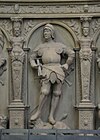 | 23 August 1388 | 1392-1417 | 2 July 1419 | County of Württemberg | Henriette, Countess of Montbéliard
1407
three children | Took part in government since 1407, and ruled in Montbéliard with his wife since 1409. |
| Regency of Henriette, Countess of Montbéliard (1419-1433) | Sons of Eberhard IV, co-ruled with their mother as regent until 1433. However, they agreed in dividing the county in 1442. Louis also inherited Montbéliard from his mother in 1444, and remodeled Urach into his residence and implemented an active policy to strengthen the monasteries in his realm of power. On his part, Ulrich inherited Stuttgart. |
| Louis I (IV) [2] | | c.1412 | 1419-1442 | 24 September 1450 | County of Württemberg | Mechthild of the Palatinate
21 October 1436
Stuttgart
five children |
| 1442-1450 | Württemberg-Urach |
| Ulrich V the Well-Loved |  | 1413 | 1419-1442 | 1 September 1480 | County of Württemberg | Margaret of Cleves
29 January 1441
Stuttgart
one child
Elisabeth of Bavaria-Landshut
8 February 1445
Stuttgart
five children
Margaret of Savoy
11 November 1453
Stuttgart
three children |
| 1442-1480 | Württemberg-Stuttgart |
| The Treaty of Nürtingen divided the County of Württemberg into two separate lines. Württemberg-Stuttgart, containing the northern and eastern parts of the old county, with the capital Stuttgart; and Württemberg-Urach, containing the southern and western parts, with the capital Urach. |
| Regency of Eberhard V, Count of Württemberg-Stuttgart (1450-1453) | |
| Louis II | | 3 April 1439 | 1450-1457 | 3 November 1457 | Württemberg-Urach | Unmarried |
| The Treaty of Münsingen reunited the two separate Lines under Eberhard V in 1482. Eberhard obtained the title of Duke in 1495. |
| Eberhard V & I the Bearded [3] |  | 11 December 1445 | 1457-1482 | 24 February 1496 | Württemberg-Urach | Barbara Gonzaga
12 April/4 July 1474
Urach
one child | Reunited the counties of Württemberg under his rule in 14 December 1482. His title was elevated to Duke in 1495. Founded the University of Tübingen, but expelled the Jews from his lands. He left no descendants, and the duchy passed to the deposed count of Stuttgart. |
1482-1495
1495-1496 | County of Württemberg
Duchy of Württemberg |
| Henry | 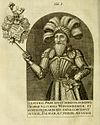 | 7 September 1448 | 1473-1482 | 15 April 1519 | Württemberg-Montbéliard | Elisabeth of Palatinate-Zweibrücken-Bitsch
(d. 17 February 1487)
1485
one child
Eva of Salm
21 July 1488
two children | The 1473 Treaty of Urach awarded the county of Montbéliard and other Württemberg possessions on the left bank of the Rhine to Henry. In the course of a dispute between Duke Charles the Bold of Burgundy and Emperor Frederick III, Charles took Henry prisoner in 1474. The captivity lasted until 1477 and Henry was treated very badly, allegedly including a mock execution. After his father's death in 1480, Henry claimed Württemberg-Stuttgart. He did not succeed, and in the 1482 Treaty of Reichenweier, he gave the county of Montbéliard to his brother, Eberhard II. |
| Montbéliard was annexed to Württemberg |
| Eberhard VI & II [3] |  | 1 February 1447 | 1480-1482 | 17 February 1504 | Württemberg-Stuttgart | Elisabeth of Brandenburg
April/May 1467
Stuttgart
no children | Deposed by the count of Urach, who reunited both halves of the county, he later achieved sovereignty over the whole Württemberg as Duke Eberhard II. But he soon ran into trouble with the nobility, who disempowered him, working in close collaboration with Maximilian I, Holy Roman Emperor. He fled to Ulm, but as he didn't find support, he was forced to accept the Arbitration of Horb in 1498, which deposed and banished him, in exchange for an annual pension of 6,000 guilders. |
| 1496-1498 | Duchy of Württemberg |
| Regency of the Estates of the realm (1498-1503) | Son of Henry and nephew of Eberhard II. Infamous for his violent tendencies, which caused marital problems, and which, at a greater extent, had him deposed in January 1519 and the duchy annexed to Austria. In exile, and away from his wife, who fled to Bavaria, he befriended Philip, landgrave of Hesse. Restored in May 1534, he aimed to bring the Reformation to the Duchy and, as Henry VIII of England was doing in his country, he also supported the Dissolution of the Monasteries. |
| Ulrich |  | 8 February 1487 | 1498-1519
1534-1550 | 6 November 1550 | Duchy of Württemberg | Sabina of Bavaria
2 March 1511
two children |
| Württemberg annexed to Austria: 1519-1534 |
| George I the Cautious |  | 4 February 1498 | 1526-1534
1553-1558 | 17 July 1558 | Württemberg-Montbéliard | Barbara of Hesse
1555
three children | Son of Henry and nephew of Eberhard II. He was deposed by his half-brother Ulrich and was only restored to his title under his nephew Christoph. |
| Montbéliard was annexed to Württemberg in 1534, and revived in 1542 |
| Christopher the Pacific |  | 12 May 1515 | 1542-1553 | 28 December 1568 | Württemberg-Montbéliard | Anna Maria of Brandenburg-Ansbach
24 February 1544
Ansbach
twelve children | He re-organized the entire administration of the church and state. He also reformed and supported the educational system. He also reconstructed the Altes Schloss in Stuttgart and hosted many celebrations. |
| 1550-1568 | Duchy of Württemberg |
| Regencies of Anna Maria of Brandenburg-Ansbach, George Frederick, Margrave of Brandenburg-Ansbach and Charles II, Margrave of Baden-Durlach (1568-77) and Wolfgang, Count Palatine of Zweibrücken (1568-69) | Left no descendants, and the duchy passed to his brother Frederick I. |
| Louis the Pious [4] |  | 1 January 1554 | 1568-1593 | 28 August 1593 | Duchy of Württemberg | Dorothea Ursula of Baden-Durlach
(20 June 1559-19 May 1583)
7 November 1575
no children
Ursula of Palatinate-Veldenz
(24 February 1572-5 March 1635)
1585
no children |
| Frederick I |  | 19 August 1557 | 1558-1593 | 29 January 1608 | Württemberg-Montbéliard | Sibylla of Anhalt
22 May 1581
Stuttgart
fifteen children | |
| 1593-1608 | Duchy of Württemberg |
| Montbéliard merged into Württemberg in 1593 |
| John Frederick | 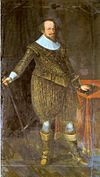 | 5 May 1582 | 1608-1628 | 18 July 1628 | Duchy of Württemberg | Barbara Sophie of Brandenburg
5 November 1609
Urach
nine children | Restored the constitution and councils abolished by his father. After the division in 1617, and as the eldest, he kept the main duchy of Württemberg |
| Louis Frederick |  | 29 January 1586 | 1617-1631 | 26 January 1631 | Württemberg-Montbéliard | Elisabeth Magdalena of Hesse-Darmstadt
(23 April 1600 - 9 June 1624)
14 July 1617
three children
Anna Eleonora of Nassau-Saarbrücken
15 May 1625
three children | Son of Frederick I, after the partition of 1617 received Montbéliard. |
| Frederick Achilles |  | 5 May 1591 | 1617-1631 | 30 December 1631 | Württemberg-Neuenstadt | Unmarried | Son of Frederick I, after the partition of 1617 received Neuenstadt. After his death without descendants, the duchy was briefly reannexed to the main Württemberg before being reassigned to his nephew. |
| Neuenstadt merged in Württemberg in 1631 |
| Julius Frederick |  | 3 June 1588 | 1617-1635 | 25 April 1635 | Württemberg-Weiltingen | Anna Sabina of Schleswig-Holstein-Sonderburg
11 December 1618
Sønderborg
nine children | Son of Frederick I, after the partition of 1617 received Weiltingen. |
| Regencies of Louis Frederick, Duke of Württemberg-Montbéliard (1628-31) and Julius Frederick, Duke of Württemberg-Weiltingen (1631-33) | Following a major defeat of Württemberg troops in the battle of Nördlingen on 6 September 1634, Württemberg was severely looted and plundered. Eberhard fled to Strasbourg, while many territories had already been passed on by the Emperor to other parties to push forward Catholicism in the region. The Duchy of Württemberg was reinstated after long negotiations resulting in the Peace of Westphalia of 1648, despite or maybe because of the effects of war, poverty, hunger and the Bubonic plague all of which reduced the population from 350,000 in 1618 to 120,000 in 1648. |
| Eberhard III | 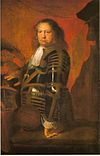 | 16 December 1614 | 1628-1674 | 2 July 1674 | Duchy of Württemberg | Anna Katharina of Salm-Kyrburg
(27 January 1614-27 June 1655)
26 February 1637
fourteen children
Maria Dorothea Sophie of Oettingen-Oettingen
(29 December 1639-29 June 1698)
20 July 1656
Ansbach
eleven children |
| Regency of George II, Landgrave of Hesse-Darmstadt and Julius Frederick, Duke of Württemberg-Weiltingen (1631-38) | Left no descendants. The duchy passed to his brother George. |
| Leopold Frederick | | 30 May 1624 | 1631-1662 | 15 June 1662 | Württemberg-Montbéliard | Sibylle of Württemberg
(4 December 1620 - 21 May 1707)
no children |
| Roderick | | 19 October 1618 | 1635-1651 | 19 November 1651 | Württemberg-Weiltingen | Unmarried | Died without descendants. The duchy went to his younger brother, Manfred. |
| Silvius I Nimrod |  | 2 May 1622 | 1647-1664 | 24 April 1664 | Württemberg-Oels | Elisabeth Marie, Duchess of Oels
1 May 1647
Oleśnica
seven children | Son of Julius Frederick, acquired the duchy of Oels by marriage. |
| Frederick |  | 19 December 1615 | 1649-1682 | 24 March 1682 | Württemberg-Neuenstadt | Clara Augusta of Brunswick-Lüneburg
7 June 1653
twelve children | Son of John Frederick, he received the duchy of Neuenstadt after the death of his uncle. |
| Manfred | | 5 June 1626 | 1651-1662 | 15 May 1662 | Württemberg-Weiltingen | Juliana of Oldenburg
31 October 1652
three children | |
| George II | | 5 October 1626 | 1662-1676
1679-1680
1697-1699 | 1 June 1699 | Württemberg-Montbéliard | Anne de Coligny
(1624-1680)
9 March 1648
Montbéliard
eight children | Under his rule the French occupied his lands twice. |
| Montbéliard occupied by France: 1676-1679, 1680-1697 |
| Frederick Ferdinand | | 6 October 1654 | 1662-1705 | 8 August 1705 | Württemberg-Weiltingen | Elisabeth of Württemberg-Montbéliard
9 September 1689
three children | Left no surviving male descendants, and the duchy was reannexed to the main duchy of Württemberg |
| Weitlingen was annexed to Württemberg in 1705 |
| Silvius II Frederick |  | 21 February 1651 | 1664-1697 | 3 June 1697 | Württemberg-Oels | Eleonore Charlotte of Württemberg-Montbéliard
7 April 1672
Oleśnica
no children | |
| William Louis |  | 7 January 1647 | 1674-1677 | 23 June 1677 | Duchy of Württemberg | Magdalena Sibylla of Hesse-Darmstadt
6 November 1673
Darmstadt
four children | Died unexpectedly, when 30 years old, of a heart-attack. |
| Frederick Charles |  | 12 September 1652 | 1677-1697 | 20 September 1697 | Württemberg-Winnental | Eleonore Juliane of Brandenburg-Ansbach
31 October 1682
Ansbach
seven children | Son of Eberhard III, founded the new Duchy of Winnental. |
| Regency of Magdalena Sibylla of Hesse-Darmstadt (1677-1693) | For his time, Eberhard Louis was a very tolerant ruler, commonly noted by modern scholars as "enlightened." Left no surviving descendants, and thus the main line went extinct. The duchy passed to Winnental branch. |
| Eberhard Louis |  | 18 September 1676 | 1677-1733 | 31 October 1733 | Duchy of Württemberg | Johanna Elisabeth of Baden-Durlach
6 May 1697
Basel
one child |
| Frederick Augustus | 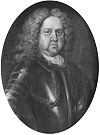 | 12 March 1654 | 1682-1716 | 6 August 1716 | Württemberg-Neuenstadt | Albertine Sophie Esther of Eberstein
9 February 1679
fifteen children | Left no male suriving descendants. The duchy passed to his brother. |
| Charles Alexander |  | 24 January 1684 | 1697-1733 | 12 March 1737 | Württemberg-Winnental | Marie Auguste of Thurn and Taxis
1 May 1727
Frankfurt am Main
six children | Previously served as regent of the Kingdom of Serbia (1720–33). In 1733, inherited the main Duchy of Württemberg. |
| 1733-1737 | Duchy of Württemberg |
| Winnental merged into Württemberg in 1733 |
| Christian Ulrich I |  | 9 April 1652 | 1697-1704 | 5 April 1704 | Württemberg-Oels | Anna Elisabeth of Anhalt-Bernburg
13 March 1672
Bernburg
seven children
Sibylla Maria of Saxe-Merseburg
(28 October 1667 - 9 October 1693)
27 October 1683
Doberlug-Kirchhain
seven children
Sophie Wilhelmine of East Frisia
(17 October 1659 - 4 February 1698)
4 February 1695
Hamburg
one child
Sophie of Mecklenburg-Güstrow
(21 June 1662 - 1 June 1738)
6 December 1700
Güstrow
no children | |
| Leopold Eberhard | | 21 May 1670 | 1699-1723 | 25 May 1723 | Württemberg-Montbéliard | Anne-Sabine Hedwiger
June 1695
(morganatic)
four children
Elisabeth Charlotte Curie
1718
Montbéliard
(morganatic)
six children | Had no legitimate descendants, and after his death the county was definitely annexed to Württemberg. |
| Montbéliard was annexed to Württemberg in 1723 |
| Charles Frederick II [5] | 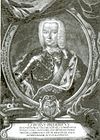 | 7 February 1690 | 1704-1744 | 14 December 1761 | Württemberg-Oels | Sibylle Charlotte Juliane of Württemberg-Weiltingen
(1690-1735)
21 April 1709
Stuttgart
no children | Abdicated to his nephew, Charles Christian Erdmann. Had no descendants. |
| Christian Ulrich II |  | 27 January 1691 | 1704-1734 | 7 February 1744 | Württemberg-Wilhelminort | Philippine Charlotte of Redern-Krappitz
(18 February 1691 - 17 June 1758)
13 July 1711
six children | Abdicated to his nephew, Charles Christian Erdmann. Had no descendants. |
| Charles Rudolph |  | 29 May 1667 | 1716-1742 | 17 November 1742 | Württemberg-Neuenstadt | Unmarried | Left no male suriving descendants. The duchy passed to his brother. |
| Neuenstadt was annexed to Württemberg in 1742 |
| Regencies of Charles Rudolph, Duke of Württemberg-Neuenstadt (1737-38) and Charles Frederick II, Duke of Württemberg-Oels (1738-46) | |
| Charles Eugene | 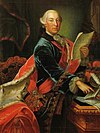 | 11 February 1728 | 1733-1793 | 24 October 1793 | Duchy of Württemberg | Elisabeth Friederike Sophie of Brandenburg-Bayreuth
26 September 1748
Bayreuth
one child
Countess Franziska von Hohenheim
10/11 January 1785
(morganatic until 1790)
no children |
| Charles Christian Erdmann |  | 26 October 1716 | 1744-1792 | 14 December 1792 | Württemberg-Wilhelminort | Marie Sophie Wilhelmine of Solms-Laubach
(1721-1793)
8 April 1741
Laubach
three children | |
| 1744-1792 | Württemberg-Oels |
| Oels was annexed to the Duchy of Brunswick-Lüneburg |
| Louis Eugene | 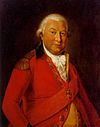 | 6 January 1731 | 1793-1795 | 20 May 1795 | Duchy of Württemberg | Countess Sophia Albertine of Beichlingen
(15 December 1728-10 May 1807)
10/11 January 1785
(morganatic)
three children | |
| Frederick Eugene | 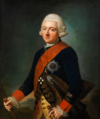 | 21 January 1732 | 1795-1797 | 23 December 1797 | Duchy of Württemberg | Friederike of Brandenburg-Schwedt
29 November 1753
twelve children | |
| Frederick II | 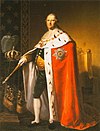 | 6 November 1754 | 1797-1803 | 30 October 1816 | Duchy of Württemberg | Augusta of Brunswick-Wolfenbüttel
15 October 1780
Brunswick
four children
Charlotte of Great Britain
18 May 1797
London
no children | In 1803, he was raised as Elector of the Holy Roman Empire, and in 1806 raised himself as king, with approval of Napoleon Bonaparte. |
|





















































